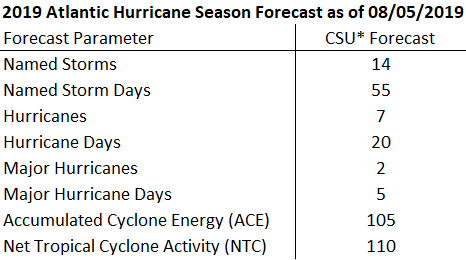Performance Tracking > 2019 Hurricane Season > Introduction
WebSitePulse 2019 Hurricane Season Web Performance and Uptime Report Intro
The hurricane season 2019 is now upon us. It is usually that distinct time of year when most tropical cyclones are expected to develop across the northern Atlantic Ocean. Whenever hurricane season is mentioned in the U.S. usually refers to the Atlantic Hurricane Season, whose storms most commonly affect the North American continent. It is an ongoing event and officially ends on November 30, 2019, however, in the past the season was defined as a shorter time frame.
According to Colorado State University’s (CSU) Tropical Meteorology Project, as from August the 5th 14 named storms, seven hurricanes, two major hurricanes and an ACE of 105 are expected until the end of this year’s Atlantic Hurricane Season. The 2019 Pacific hurricane season has also started. On May 25, 2019, the National Oceanic and Atmospheric Administration released its annual forecast, predicting a 90% chance of a near- to an above-average season in both the Eastern and Central Pacific basins, with a total of 14–21 named storms, 6–13 hurricanes, and 3–9 major hurricanes. Similar is the Servicio Meteorológico Nacional’s (SMN) first forecast for the season, predicting a total of 18 named storms, ten hurricanes, and seven major hurricanes to develop.
The 2019 Pacific hurricane season has also started. On May 25, 2019, the National Oceanic and Atmospheric Administration released its annual forecast, predicting a 90% chance of a near- to an above-average season in both the Eastern and Central Pacific basins, with a total of 14–21 named storms, 6–13 hurricanes, and 3–9 major hurricanes. Similar is the Servicio Meteorológico Nacional’s (SMN) first forecast for the season, predicting a total of 18 named storms, ten hurricanes, and seven major hurricanes to develop.
For 14th consecutive year, WebSitePulse will provide free monitoring and notifications during 2019 hurricane season to five of the most popular websites that present their users with real-time forecasts, emergency information and donation opportunities in times of hurricanes, floods, and other natural or man-caused disasters.
The WebSitePulse Performance Reports will measure the websites’ uptime and response time as the most important metrics for the availability and the reliability of any web-based operation, critical for the End Users' overall online experience. Measurements of web transactions will be made every 15 minutes, simultaneously from 3 different monitoring locations. In-depth analytical information is also collected and stored in the WebSitePulse system for future references.
According to Colorado State University’s (CSU) Tropical Meteorology Project, as from August the 5th 14 named storms, seven hurricanes, two major hurricanes and an ACE of 105 are expected until the end of this year’s Atlantic Hurricane Season.

For 14th consecutive year, WebSitePulse will provide free monitoring and notifications during 2019 hurricane season to five of the most popular websites that present their users with real-time forecasts, emergency information and donation opportunities in times of hurricanes, floods, and other natural or man-caused disasters.
The WebSitePulse Performance Reports will measure the websites’ uptime and response time as the most important metrics for the availability and the reliability of any web-based operation, critical for the End Users' overall online experience. Measurements of web transactions will be made every 15 minutes, simultaneously from 3 different monitoring locations. In-depth analytical information is also collected and stored in the WebSitePulse system for future references.
